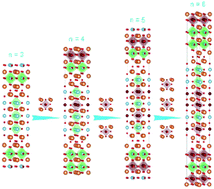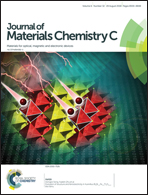Evolution of structure and ferroelectricity in Aurivillius Bi4Bin−3Fen−3Ti3O3n+3 thin films†
Abstract
Ferroelectric Aurivillius thin films Bi4Bin−3Fen−3Ti3O3n+3 (BFTO n = 3, 4, 5, 6) were successfully prepared on platinum-coated silicon substrate by chemical solution deposition and the ferroelectric polarization properties were investigated and detailed. Simultaneously, the dielectric and leakage current characteristics of the thin films were obtained. Evolution of the Aurivillius layer structure was confirmed by XRD and HR-TEM results. A saturated hysteresis loop with larger remanent polarization (2Pr) and excellent retention properties are observed in all thin films. The values of 2Pr in the film capacitors are all about 50 μC cm−2 besides the n = 3 film, in which the leakage current increases significantly in larger electric fields. The leakage current values of films Bi5FeTi3O15, Bi6Fe2Ti3O18 and Bi7Fe3Ti3O21 gradually increased with increasing n, and the leakage current mechanism was studied by various conduction mechanisms. The combined relationships of the ferroelectric polarization, leakage current, polarization fatigue and retention of BFTO thin films are discussed in terms of the structural characteristics, aggregation of oxygen vacancies and crystallite grain size in the films. The results of optimization of the ferroelectric properties in Aurivillius phase thin films with higher n by chemical solution deposition are useful for further exploration of single-phase multiferroics in the Aurivillius family and other layer structure compounds with potential applications in the field of ferroelectric-based data storage.



 Please wait while we load your content...
Please wait while we load your content...